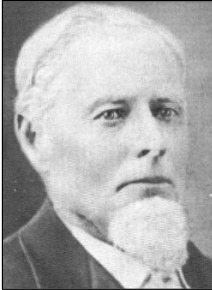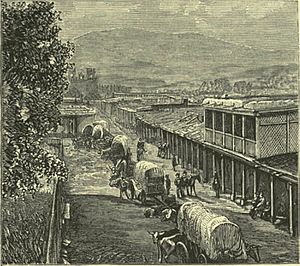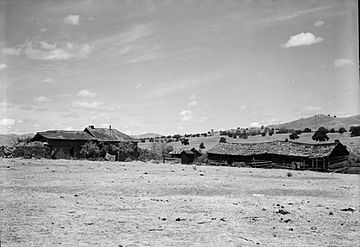Gillum Baley facts for kids
Quick facts for kids
Gillum Baley
|
|
|---|---|

Baley circa 1885
|
|
| Born | 19 June 1813 |
| Died | 11 November 1895 (aged 82) |
| Known for | American pioneer and County Judge of Fresno County, California |
Gillum Baley (born June 19, 1813 – died November 11, 1895) was an American pioneer and a judge. He helped lead the Rose–Baley Party, which was the first group of settlers to try traveling from New Mexico to California using Beale's Wagon Road. He was one of the first people to settle in Bailey Flats, California, which was named after him. Later, he lived in Millerton, where he worked as a County Judge for twelve years.
A Young Pioneer's Life
Gillum Baley was born in Illinois. His family moved to Missouri when he was very young. At age 13, he went back to Illinois to work on farms.
In 1832, when he was 19, Gillum joined the Illinois Mounted Militia during the Black Hawk War. This was a conflict between the United States and Native American tribes. He was chosen as a sergeant. After the war, he married Catherine Decker. Sadly, she died in 1836, leaving him with a baby son named Moses.
Gillum then moved back to Missouri. He farmed and raised animals. He also married Permelia Eleanor Myers. He became a justice of the peace, which meant he helped settle small legal problems in the community.
In 1849, the California Gold Rush began. Gillum and his brothers traveled to California to find gold. Gillum stayed for two years before returning to his family. He was sure that California was where he wanted to live.
The Rose–Baley Party's Journey

In April 1858, Gillum Baley and his brother Right decided to move their families to California for good. Gillum and Permelia had nine children, and Right and Nancy had eight. They formed a wagon train with other families.
In May, they met another group led by Leonard John Rose. They decided to travel together for safety. When they reached Albuquerque, New Mexico, they chose to try a new route to California called Beale's Wagon Road. It was a very rough trail.
On August 30, as they were about to cross the Colorado River, their group was attacked by Mojave Indians. Twelve people were hurt, and eight died, including five children. They lost most of their animals and were afraid of more attacks. The survivors walked 500 miles back to Albuquerque.
The Baley families reached Albuquerque safely in November 1858, even though the journey was very hard. They tried to reach California two more times. The first try failed because their cattle died. They finally made it to California on their third attempt in 1859. They crossed the Colorado River at Fort Yuma and settled in Visalia.
Life in California

In 1860, Gillum Baley moved his family near Fort Miller. They lived in old army buildings. He earned money from mining in the nearby rivers. This helped him buy animals and land. He built a home and started a cattle and dairy farm in an area now called Bailey Flats.
In 1862 and 1863, big floods washed away his homestead. The family then moved to Millerton, which was the main town of Fresno County at the time. Gillum became a justice of the peace again. In 1867, he was elected County Judge. He held this important job for 12 years.
After retiring in 1878, Gillum and his wife moved to Fresno. He started a grocery business with his son-in-law. He was also elected County Treasurer. However, he lost all his money in the panic of 1893, which was a big economic crisis.
Gillum and his wife were in their seventies. They had to turn their home into a boarding house to earn money. Gillum also tried to get money from the government for the losses from the 1858 Mojave attack. His claim was not approved, but he died in 1895 before the final decision.
Gillum Baley's funeral was held at St. Paul's Methodist Church in Fresno, which he had helped start. He and his wife Permelia are buried together in the Academy Cemetery in Clovis, California.
Gillum Baley appears as a character in the 1995 children's book Sallie Fox: The Story of a Pioneer Girl. This book is about Sallie Fox, who was 12 years old and traveled with the Rose-Baley Party. She survived the Mojave attack and the difficult journey back to Albuquerque. Like the Baley family, she and her family eventually reached California in 1859.

